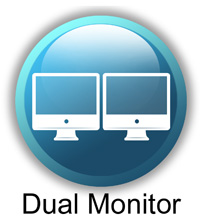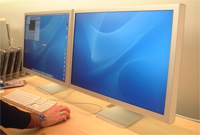Dual Monitors
HIS Technology, January 1, 2008
 Few PC users have ever experienced the huge productivity boost that comes from using multiple monitors on the same PC. Ironically, many of today's PC have the capability already installed, and Windows (since 2000) natively supports dual monitors. Configuring dual monitors is so easy: just use the second video port (if there are two separate ports installed), or add a second video card or better yet, a video card that has dual DVI ports. Then plug in your second monitor, change a couple of simple Windows settings, and you have double the Windows Desktop. This lets you have your spreadsheet and email visible at the same time, or PowerPoint and Photoshop. The combinations are endless. And since most of the overhead is handled by the video card, there is little significant impact (if any) on system performance. Dual Monitors is one of the simplest, yet most amazing productivity boosters you can add to your PC! Optionally, you can use a dual monitor stand and recover your workspace in the process!Clone mode
Few PC users have ever experienced the huge productivity boost that comes from using multiple monitors on the same PC. Ironically, many of today's PC have the capability already installed, and Windows (since 2000) natively supports dual monitors. Configuring dual monitors is so easy: just use the second video port (if there are two separate ports installed), or add a second video card or better yet, a video card that has dual DVI ports. Then plug in your second monitor, change a couple of simple Windows settings, and you have double the Windows Desktop. This lets you have your spreadsheet and email visible at the same time, or PowerPoint and Photoshop. The combinations are endless. And since most of the overhead is handled by the video card, there is little significant impact (if any) on system performance. Dual Monitors is one of the simplest, yet most amazing productivity boosters you can add to your PC! Optionally, you can use a dual monitor stand and recover your workspace in the process!Clone mode
Initially on PCs, the multiple output interface was designed to display the same image on all output interfaces (sometimes referred to as mirroring or cloning). This reflected the fact that these video cards were originally used in presentations where the user typically had his or her face to the audience with a duplicate of the projected image available to the presenter.
Clone mode
Initially on PCs, the multiple output interface was designed to display the same image on all output interfaces (sometimes referred to as mirroring or cloning). This reflected the fact that these video cards were originally used in presentations where the user typically had his or her face to the audience with a duplicate of the projected image available to the presenter.
Extended mode
 In "extended" mode, additional desktop area is created on additional monitors. Each monitor can use different settings (resolution, color, refresh rate). Macintosh computers have supported the "extended desktop" concept since the late 1980s, increasing the platform's utility for professional media and software developers such as graphic designers, video editors, and game developers.
In "extended" mode, additional desktop area is created on additional monitors. Each monitor can use different settings (resolution, color, refresh rate). Macintosh computers have supported the "extended desktop" concept since the late 1980s, increasing the platform's utility for professional media and software developers such as graphic designers, video editors, and game developers.
The concept was further developed by PC manufacturers and led to the "extended" or "independent displays" mode and the "spanning" or "stretched" display mode. In both of these modes, display devices are positioned next to each other in order to create the illusion that the two displays are logically contiguous.